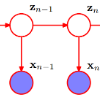Central to the digital transformation of the process industry are Digital Twins (DTs), virtual replicas of physical manufacturing systems that combine sensor data with sophisticated data-based or physics-based models, or a combination thereof, to tackle a variety of industrial-relevant tasks like process monitoring, predictive control or decision support. The backbone of a DT, i.e. the concrete modelling methodologies and architectural frameworks supporting these models, are complex, diverse and evolve fast, necessitating a thorough understanding of the latest state-of-the-art methods and trends to stay on top of a highly competitive market. From a research perspective, despite the high research interest in reviewing various aspects of DTs, structured literature reports specifically focusing on unravelling the utilized learning paradigms (e.g. self-supervised learning) for DT-creation in the process industry are a novel contribution in this field. This study aims to address these gaps by (1) systematically analyzing the modelling methodologies (e.g. Convolutional Neural Network, Encoder-Decoder, Hidden Markov Model) and paradigms (e.g. data-driven, physics-based, hybrid) used for DT-creation; (2) assessing the utilized learning strategies (e.g. supervised, unsupervised, self-supervised); (3) analyzing the type of modelling task (e.g. regression, classification, clustering); and (4) identifying the challenges and research gaps, as well as, discuss potential resolutions provided.
翻译:暂无翻译




